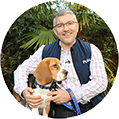Do dogs have a favourite person? And what if they seem to like your partner, your child or even the postman more than you? We find out whether our pets have ‘people preferences’, and what to do if it gets out of hand…
Think back to the early days of your dog’s arrival into your life. Who put in the hours with your new pet? Who fed and walked them most often? Who played their favourite games, gave them their top toys and rewarded their training achievements with meaty treats and lavish praise? If it was you, then you might reasonably expect to be your dog’s favourite human – and chances are you already are.
Those first months when your dog is developing an understanding of their home environment are incredibly powerful for bonding. It’s quite normal and natural for a dog to focus a little more on their leading caregiver, simply because they’re having stimulating and enjoyable encounters with that person.
It doesn’t always follow, however, that your four-legged family member will automatically become your best friend – even if you happen to be the person spending the most time with them. The crushing moment when you think ‘my dog prefers someone else’ can really hurt.
Why do dogs like some people more than others?
In addition to factors such as who has been able to spend the most bonding time with your dog, your pet’s own personality may also dictate who they are most drawn to. All dog behaviourists have encountered situations where it’s the more aloof, less involved human member of the household who is the chosen one! Even if you are their main caregiver, some dogs are put off by overenthusiasm and gravitate towards the person who is calmer, with an even temperament (that’s perhaps more like their own).
How to bond with your dog
Rather than getting hung up on how to become your dog’s favourite person, think about the behaviour of all your household members, and about their day-to-day interactions with the dog. You want to try and balance the affection and quality time that your pet gets from everyone around them. This could mean making sure that the ‘less popular’ person takes on more canine caring duties, if possible, to help integrate them more deeply into the dog’s world. In most circumstances, your dog will then begin to see that individual in a more positive light.
Consistency, especially around rule-setting and boundaries, is also important. If one member of the family has been crowned your dog’s favourite because that person tends to spoil them, now is the time to stop!
How to deal with a possessive dog
Some situations call for a more robust strategy – for example, when a dog is so possessive of one household member that they become aggressive or defensive towards any ‘competitor’. This behaviour can occur in almost every type of dog breed. Some dogs become so attached that they’ll constantly shadow one family member, wriggling their way into prime positions on the sofa to create a barrier against anyone they view as stealing their favourite human.
Inadvertently allowing a dog to get to the stage of dominating family relationships risks creating a battleground for favouritism, and isn’t healthy for either you or your pet. So if this situation sounds familiar, you’d be well advised to reduce the amount of access your dog has to their favourite person – as well as promptly removing your dog from the sofa if they’re guarding it.
The preferred family member should also try not to be too gushing and indulgent towards the dog. This will help shift the balance of power and encourage your dog to build connections with others in the household.
Use your voice
There are times when you may need to come across a bit more assertively, to help the rebalancing process. Be prepared to use the range of your voice to convey a clear message to your dog. But that doesn’t mean shouting at them! If you say ‘on your bed’, ‘lie down’ or ‘stay’, project the words with clarity and firmness, so there’s no doubt that it’s a command. Contrast that with playing with your dog or teaching them new tricks, when a softer, chit-chat tone may be more appropriate. Training people how to use their voice might sound odd, but it can change their relationship with the dog profoundly for the better.
Rescue dogs and favouritism
A more deep-rooted issue with favouritism can occur if you’ve welcomed a rescue dog into your home. The stresses that some rescue animals have experienced can surface as mistrust, fear, aggression or a reluctance to engage. The triggers for rescue dogs can be wide-ranging: long hair, hats, glasses or just a certain tone of voice may send their stress levels skyrocketing. Meanwhile, nervous rescue dogs often latch on to one person in the household very strongly. In extreme cases, they may suffer separation anxiety if that particular person isn’t around.
The best way to bond here is for the less trusted person to give their dog ample space to check them out in the dog’s own time. Trying to push your new pet into liking you is more likely to backfire. The best route is to provide valuable trust-building opportunities.
Bonding tips for rescue dogs
- These ideas can help you build a bond with an anxious or timid rescue dog:
- Dogs are hugely motivated by food. Aside from doing the feeding regularly, toss a treat forward to the dog, then step well back, so they feel safe enough to come forward and take it.
- Put a toy into your dog’s bed or crate so that you start to be perceived as a source of good things.
- Introduce a game or two, to add to the stack of positives the dog now associates with you.
- Looking into a dog’s eyes is one of the most meaningful ways to bond, but it can feel too invasive for an anxious rescue dog. Instead, extend a hand to give them a stroke, but don’t seek eye contact. Be patient, and eventually they should engage.

Do you think we’re doing a good job? If you do, please vote for us in this year’s Insurance Choice Awards. Plus, you’ll also be entered into a prize draw to win £1,000 (Ts&Cs apply)
